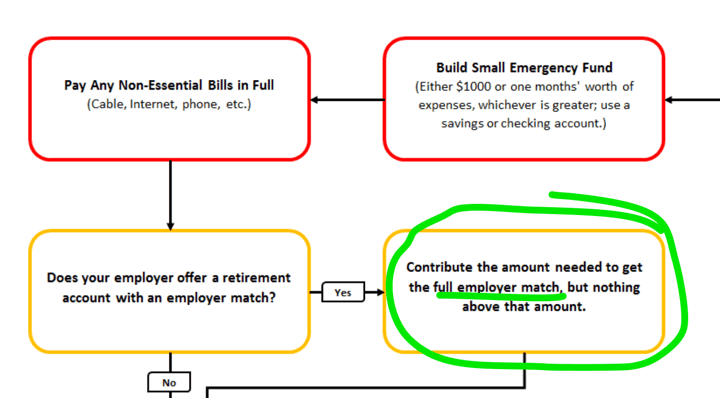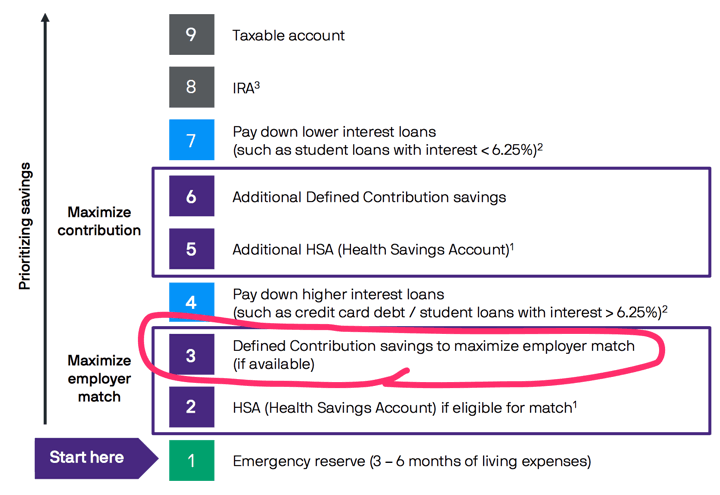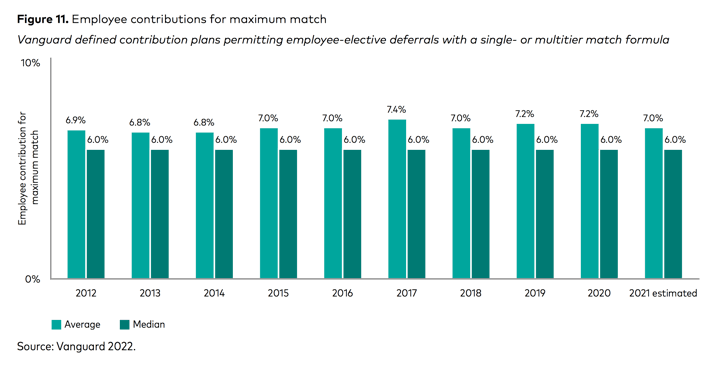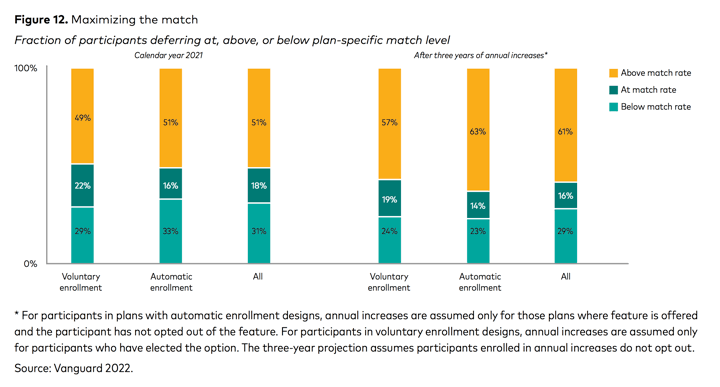At the top of many personal finance “To-do Lists” is to max out the employer match offered in your 401k/403b retirement plan. It’s usually the first “savings” step after paying down high-interest debt and keeping up with your bills. Here’s a screenshot from the Standardized Personal Finance Advice Flowchart via Reddit:

And here it is again from JP Morgan Asset Management, right after building up an emergency fund:

I’ve read this advice so many times, but how many people even complete this Top 3 item on the list? To be clear, this is just contributing enough to maximize your employer match contribution, not maxing out your allowable employee contribution. (That’s on the list of standardized advice as well, but at a slightly lower priority level.)
Vanguard recently released its How America Saves 2022 report with tons of data about the retirement accounts that they help manage. Let’s see what they found.
First of all, what does it take to max out your 401k company match? Roughly a 6% contribution rate over the years.

So… how many people actually max out their 401k company match? Roughly 70% of participants contributed at least the max match rate in 2021. For participants in plan with an auto-increase feature, this number goes up to 77% overall after three years.

If you aren’t at least maxing out the company match and getting your “free money”, hopefully this stat provides some peer pressure. Over 2/3rds are doing it! You don’t want to be below-average, do you?? 😱
 The Best Credit Card Bonus Offers – 2025
The Best Credit Card Bonus Offers – 2025 Big List of Free Stocks from Brokerage Apps
Big List of Free Stocks from Brokerage Apps Best Interest Rates on Cash - 2025
Best Interest Rates on Cash - 2025 Free Credit Scores x 3 + Free Credit Monitoring
Free Credit Scores x 3 + Free Credit Monitoring Best No Fee 0% APR Balance Transfer Offers
Best No Fee 0% APR Balance Transfer Offers Little-Known Cellular Data Plans That Can Save Big Money
Little-Known Cellular Data Plans That Can Save Big Money How To Haggle Your Cable or Direct TV Bill
How To Haggle Your Cable or Direct TV Bill Big List of Free Consumer Data Reports (Credit, Rent, Work)
Big List of Free Consumer Data Reports (Credit, Rent, Work)
I’m actually pleasantly surprised that so many people are getting the full match.
The way things are reported sometimes you get the idea that hardly anyone in USA saves for retirement. But full 70%+ of people hitting the match rate of 6-7% or more is pretty good.
… on 2nd thought, I just realized this is just “of plan participants”. So its only counting the people who contribute.
Only 51% of private employees participate in 401ks.
https://www.bls.gov/opub/ted/2021/68-percent-of-private-industry-workers-had-access-to-retirement-plans-in-2021.htm
Thanks for pointing us to this interesting report. I saw on page 5 that 81% of their plan participants used target-date funds in 2021. I wonder if the current management at Vanguard would embrace the target-date concept as enthusiastically as previous management?
Figure 30 on page 31 shows the dramatic impact of automatic enrollment, especially for younger employees. For example, 93% of 25-34 year olds participated in their 401k plan if they had automatic enrollment. Without automatic enrollment, only 59% participated. Another good innovation.
I’m 42 and have $11K is student loans ($6K @ 3.35% and $5K @ 3.5%). I’ve completed steps 1-6 in the JP Morgan graphic. Is it better to focus on paying down my student loans like the graphic suggests, or would it be better to max out my Roth IRA? I’ve currently been maxing out my Roth, but am curious to hear any suggestions others may have.
It looks like maxing out your Roth IRA would be part of #6 in the JP Morgan graphic. That seems like a good strategy. The interest rate on your student loans isn’t very high, you’re probably good just making the regular payments.
Also, you may want to wait and see if you qualify for the possible $10,000 write-off on student loans that the president seems to be considering. I’m not commenting on whether that’s a good idea or not, but if they move forward, you might as well take advantage…if you qualify.
I recently switched jobs, and I’d already significantly more than the 6%. However, I’m not sure they’ll true up the matching. Is that even legal? Is there a way to ask for the matching once you’ve left?
I dig your blog Johnathan. Long time follower. In that, I mean years and years. Thanks.